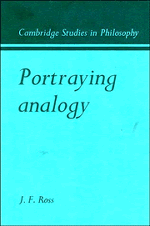Book contents
- Frontmatter
- Contents
- Dedication
- Preface
- Introduction
- 1 The limitations of classical analogy theory and the Miller's Analogies transition
- 2 The genus: meaning differentiation
- 3 Predicate schemes: an explanatory model
- 4 Equivocation, analogy and metaphor
- 5 Denominative analogy and paronymy
- 6 Figurative discourse
- 7 Analogy and religious discourse: craftbound discourse
- 8 Analogy and analysis
- Notes
- Bibliography
- Name index
- Subject index
4 - Equivocation, analogy and metaphor
Published online by Cambridge University Press: 07 October 2011
- Frontmatter
- Contents
- Dedication
- Preface
- Introduction
- 1 The limitations of classical analogy theory and the Miller's Analogies transition
- 2 The genus: meaning differentiation
- 3 Predicate schemes: an explanatory model
- 4 Equivocation, analogy and metaphor
- 5 Denominative analogy and paronymy
- 6 Figurative discourse
- 7 Analogy and religious discourse: craftbound discourse
- 8 Analogy and analysis
- Notes
- Bibliography
- Name index
- Subject index
Summary
INTRODUCTION
Earlier chapters show how mere equivocation, analogy of proportionality and metaphor all result from the domination of susceptible words by contrasting, scheme-intransigent expressions.
‘Pen’ is indifferent to instrument schemes (that include ‘pencil’, ‘quill’, ‘stylus’, etc.) and to enclosure schemes (that include ‘stall’, ‘paddock’, ‘run’, etc.). The verb ‘wrote’ is indifferent to means expressing schemes (that include ‘telephoned’, ‘telegraphed’, ‘semaphored with’, ‘drew with’, ‘inscribed with’, ‘signed with’, etc.). Yet, concatenated into ‘He wrote with a pen’, ‘wrote’ is not indifferent to the enclosure scheme for ‘pen’; rather, it is resistant because it belongs to a means demanding scheme which, concatenated with that enclosure scheme, would in the supposed environment yield an unacceptable sentence, e.g. ‘He wrote with a barnyard enclosure’. ‘Wrote’ dominates ‘pen’. And ‘pen’, thus determined, reciprocally dominates ‘wrote’ to exclude the means expressing scheme (‘telegraphed’, etc.) because that result would be similarly unacceptable.
Of course, in a story about stock exchange trading, ‘He telegraphed with his pen’ could mean that he sent a message by a motion of his pen, and the context would be read so as to make ‘telegraphed’ means-demanding (‘with his pen’). And ‘ink’ doesn't always dominate ‘pen’. In a story about counterfeiters hiding their ink somewhere on a farm, ‘They put the ink into the pen’ might not have ‘ink’ dominating ‘pen’. Still, ‘He put the pen into the ink’ would usually have ‘ink’ dominating because of the tight syntactical link to ‘pen’ and the commonplace improbability of the other reading.
- Type
- Chapter
- Information
- Portraying Analogy , pp. 86 - 120Publisher: Cambridge University PressPrint publication year: 1982

